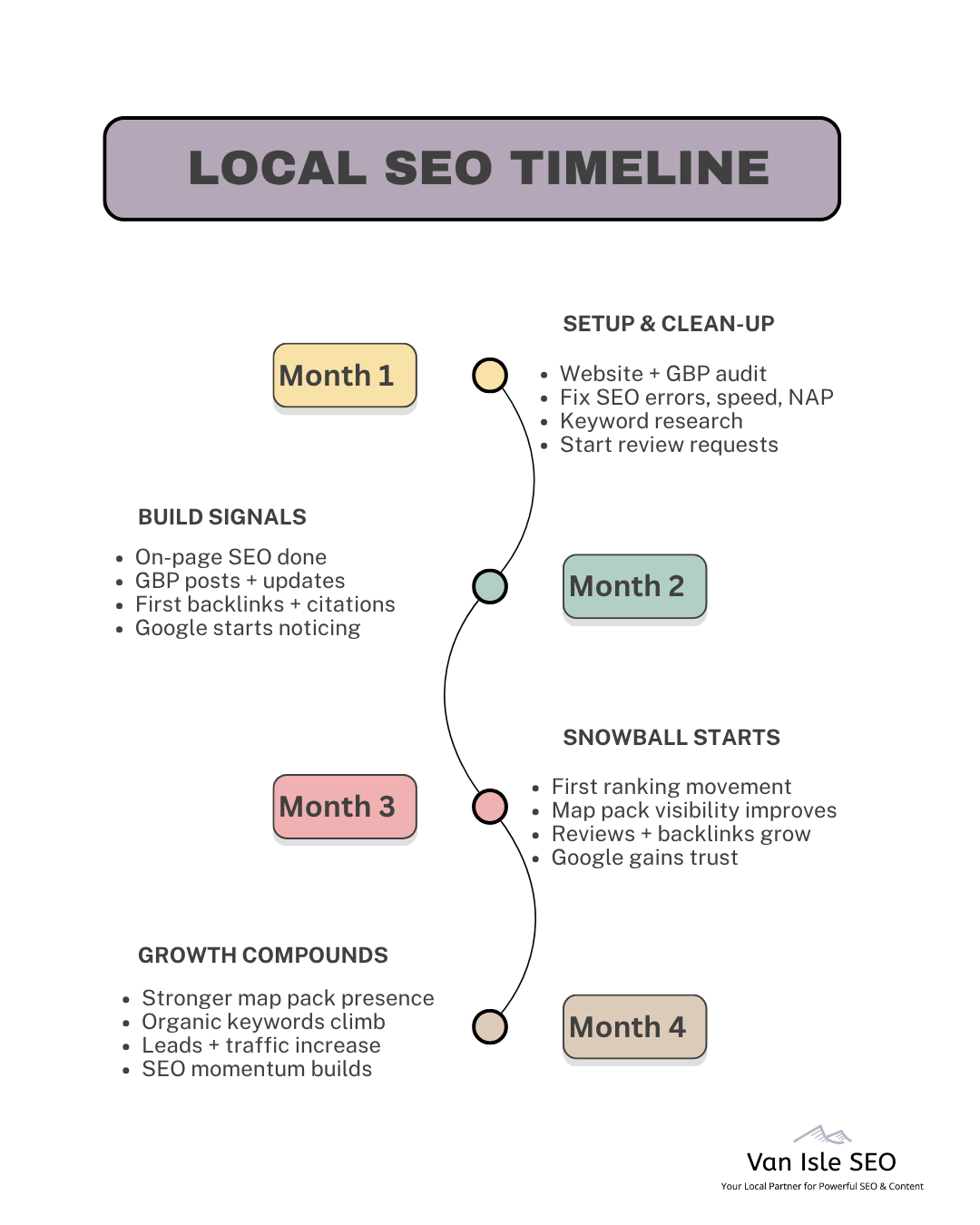Local SEO: How Long It Really Takes Your BC Business to Rank on Google
One of the first questions I hear from almost every business owner I speak to is how long SEO actually takes. And honestly, it’s a fair question because the internet is full of vague answers, false promises, and generic timelines that don’t reflect how SEO actually works for local businesses. The truth is, the timeline depends on one simple thing that most SEO agencies don’t like to talk about – it depends on where you start, where your competitors are, and how competitive your market really is.
From what I see, businesses in smaller towns like Nanaimo, Parksville, or Port Alberni generally see movement within the first three to four months. That means progress in the local map pack, service keywords moving upwards, and usually a noticeable increase in phone calls and inquiries. But when I look at businesses in competitive markets like Vancouver, Surrey, or Victoria, the timeline looks very different. In those markets, it often takes six to nine months, sometimes even longer, because there are more competitors who have been investing in SEO for years – and Google doesn’t reward the newest player overnight just because the website got updated.
Consistency is Key: You have to be patient to win the Local SEO Marathon
The other thing most people underestimate is how much the starting point influences the timeline. If your website is already clean, mobile-friendly, loads quickly, and the basics are set up properly – meaning you’ve got a Google Business Profile that’s mostly filled out, a few decent backlinks, and at least some online presence – then the job is more about improving and scaling and adjusting your local strategy and matching it to what you stand for as a local brand. That always goes faster. But if you’re starting from zero, meaning an outdated website, a broken Google listing, zero reviews, and no backlinks, then the first months are simply about getting Google to notice you at all. Google doesn’t trust a business just because it suddenly shows up with a new website. It needs proof – local SEO trust signals that stack up over time.
Local SEO doesn’t work overnight — it builds.
The pattern I see with every single client is always the same. SEO starts slow. The first two or three months are about cleaning things up, fixing what’s broken, setting the right signals, and giving Google a reason to even care. And for us as SEO experts it means a lot of educational work and the inflationary use of the phrase “it depends”.
Then, once that foundation is there, growth starts – and it compounds. It’s a snowball effect. The longer you stay consistent, the faster it grows. But it’s never a light switch. This is also exactly why SEO wins long-term over ads. Paid ads stop the second you stop paying. SEO keeps working – even if you slow down – because it’s a permanent asset in Google’s ecosystem.
Google doesn’t just rank websites — it ranks businesses. If your local branding is weak, SEO alone won’t carry the weight. And if your SEO is broken, no one will find you no matter how good your reputation is.
Local SEO vs. Traditional SEO – Why It’s a Completely Different Game for Service Businesses
If there’s one thing that confuses business owners more than anything else about SEO, it’s the idea that all SEO is the same. It’s not. What works for an e-commerce company or a national brand does not translate to a contractor, a dentist, or a roofer who relies on local customers finding them in Google. And this misunderstanding is exactly why so many generic SEO agencies fail when it comes to delivering results for local businesses. They’re simply running the wrong playbook.
Local SEO is about visibility within your community. It’s not about ranking nationwide. It’s about showing up when someone types “roof repair near me” or “dentist Nanaimo” or “family lawyer Victoria.” Google’s algorithm for local search works very differently from traditional organic search because it takes into account things like proximity, local relevance, reviews, and your Google Business Profile signals — things that are irrelevant to someone trying to sell products nationally.
Local Map Pack wins! But it’s also about the Local-Brand-Local-SEO-Ratio
When I work with local service businesses, the absolute priority is getting into the local map pack. That’s where most of the calls come from. If you’re not in those top three results under the map, you’re invisible to most searchers. That’s just the reality. Google Business Profile optimization, local backlinks, accurate directories, and review management are not optional – they’re the foundation.
Traditional SEO, by comparison, is a completely different beast. That’s the game for national brands, software companies, online stores, or content-driven websites. It’s built around high-volume link building, massive technical optimization, and content strategies designed for scale, not location. For those websites, there’s no Google map involved. There’s no proximity factor. None of the local ranking signals matter.
And this is exactly where what I call the Local-Brand-Local-SEO Ratio comes into play. Because no matter how well your SEO is executed technically, it has to match the strength of your local brand presence. In simple terms, if your local brand is weak – meaning no one’s talking about you, there are no reviews, no brand searches, and your digital footprint is basically empty – then even the best SEO strategy won’t carry the full weight on its own. I see it over and over again. If your offline brand presence is a 2 out of 10, but your SEO efforts are running at a 9 out of 10, it’s not balanced, and Google notices that.
The businesses that win locally almost always show a balanced ratio. Their brand is known within the community, customers leave reviews, people search for them by name, and their SEO backs that up with the technical foundation, the right on-page signals, and the trust factors Google wants to see. It’s not SEO or branding — it’s SEO plus branding working together. If one side is missing, growth is either slower or never reaches its full potential.
This is exactly why I say it straight to every client – if an SEO agency offers you a one-size-fits-all SEO package that doesn’t differentiate between local SEO and general SEO, you should walk away. The strategies that help a roofer in Nanaimo show up when someone searches for “roof repair” are not the same strategies that help Amazon rank for “buy running shoes.” If you don’t adjust the approach, it simply doesn’t work. Google isn’t stupid. It knows the difference between a local service business and an online store – and it evaluates them on completely different sets of signals.
At the end of the day, local SEO is not a simplified version of SEO. It’s a completely specialized approach designed for businesses that rely on local customers. If your SEO strategy doesn’t focus on Google Business Profile optimization, proximity relevance, review signals, and localized content, then it’s not really local SEO – and it’s not going to get you where you need to be











